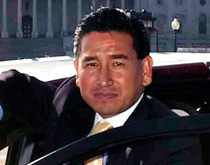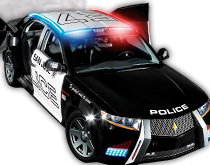
William Santana Li glances at the clock as the phone rings. It's 11 a.m. He has a feeling the caller is Stacy Dean Stephens. Li mentally reviews the email that Stephens, a Dallas-area police officer, sent him the day before. Stephens had outlined an idea of how to lessen the inherent danger of police work--the high-speed chases, the confrontations, the life and death situations. The pitch moved Li. He just isn't sure he can help. The phone keeps ringing.
It made sense that Stephens approached the young executive. Li has an impressive résumé—from graduating in 1991 with a Carnegie Mellon engineering degree in just three years, to being Ford's youngest senior executive worldwide at the age of 28, to securing $250 million for a Ford subsidiary.
Li says he has always had an interest in and fascination with the automotive industry. "Everything comes together in this industry—the creative plus the technical, the rational and the irrational. It's where brands and customers and technology, finance and operations, all come together to an actual product that you can touch and feel and that stirs the emotions of the kid in every single one of us."
Certainly, starting a new homeland security company from scratch, one that would build a vehicle specifically for police officers, would be a daunting and thrilling challenge, a challenge Stephens presented in his email. With more than a little trepidation, Li answers the phone. It's Stephens. Thirty days later, in February 2003, Carbon Motors Corporation is born.
Six years later, Li hasn't second-guessed himself. "The 840,000 law-enforcement first responders get up every morning, and they don't know if they're coming home that night. The least we can do is to give them the appropriate equipment that they so sorely need. We have a duty and moral obligation to these brave women and men in a uniform," he says. "Fire departments have their own vehicles, the hospitals have ambulances, and the military has a huge fleet of purpose-built vehicles. Even your mailman and garbagemen have special vehicles. But somehow police officers drive a vehicle designed in the 1970s meant to take you on a Sunday drive."
But Li, chair and chief executive officer of Carbon Motors, knows that fascination and passion alone don't equal success. From the beginning, he set out to assemble a strong management team, starting with making co-founder Stephens the sales development manager. The company needed a chief financial officer, too. Enter Keith Marchiando.

Li and Marchiando hadn't met, though they probably should have. Both worked at Ford and both attended Carnegie Mellon during overlapping years. Marchiando earned his MBA from the Tepper School in 1990, following in the steps of his parents, Richard Marchiando (IM'60) and Barbara Woods Marchiando (MM'59). While at Carnegie Mellon, he was buggy chair for Phi Kappa Theta fraternity and was one of the last male drivers. "There is nothing as exhilarating as having your chin six inches off the ground going 50 miles an hour," he says. Stephens, in the line of duty, might beg to differ.
After graduation, Marchiando, like Li, worked for Ford, including product development of the Crown Victoria, the predominant vehicle used for police cars. When a headhunter approached Marchiando for Carbon's CFO position, the two men's paths would finally cross. "Keith has a tremendous wealth of experience accumulated over a relatively short period of time," says Li. "He's more than well educated. He's got the experience of working at an automaker. I wanted someone that spent quality time at an automaker plus experience in the supply base, finance, and being CFO of a publicly traded company. And Keith has it all."
One of the first things the management team did was form the "Carbon Council," essentially a users group of more than 3,000 police officers across the United States. "We were creating a tool for law-enforcement officers to be able to do their job better, so who better to ask," says Marchiando.

The council developed more than 100 key requirements for the Carbon E7 law-enforcement vehicle. The running prototype (which at various stages was designed and engineered in Georgia, Arizona, California, Michigan, the United Kingdom, and Germany) is now built. It's a 300-horsepower, clean-diesel, high-performance automobile that includes sensors for weapons of mass destruction, an automatic license plate scanner, a purpose-built driver's seat to accommodate an officer wearing 30 pounds of equipment, and full 360 degree emergency lights to increase visibility and safety during road stops and pursuits. The engine will improve fuel economy and also reduce carbon dioxide emissions by 40 percent compared to a traditional automobile.
Li, Marchiando, and Stephens have embarked on what they call the Pure Justice Tour to introduce the Carbon E7 to police officers, government officials, and the media—giving them a chance to push the dashboard controls, interface with the integrated law-enforcement equipment, sit in the custom-designed seat, and yes, literally kick the tires.
Pricing and a production schedule haven't been finalized, but so far Carbon Motors reports production slot reservations exceeding 10,000 units and is on track to have the first year of production easily sold out. Carbon's management expects production to begin calendar year 2012.
Obviously, Li, Marchiando, and Stephens are pleased with the interest and support for the Carbon E7, as is Carbon's Advisory Board, which includes Gov. Tom Ridge, former Secretary of the U.S. Department of Homeland Security; Congressman Lee Hamilton, 9/11 Commission vice chair; and Lee Brown, former New York police commissioner and President Clinton's drug czar.
What has pleased Li most, though, is that he answered the phone at 11 a.m. six years ago. "I remember the Pure Justice Tour stop in Columbus, Ohio, last year," says Li. "An Ohio state patrol officer just stood in front of the car quivering with a tear in his eye and said, 'I don't know what to say. You guys have thought of everything.'"



